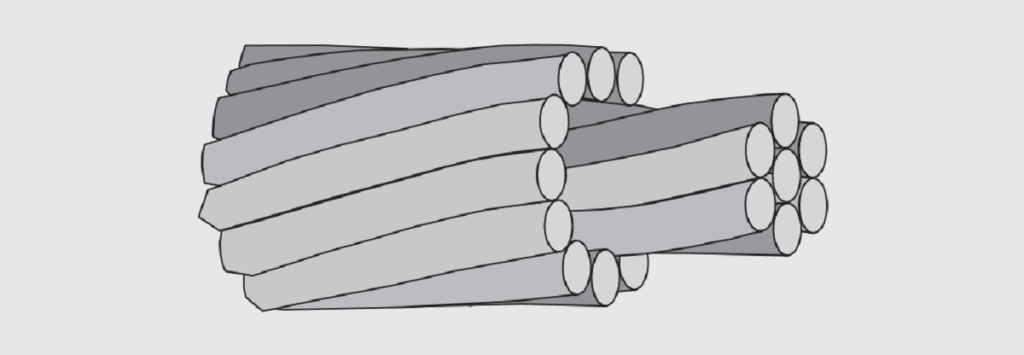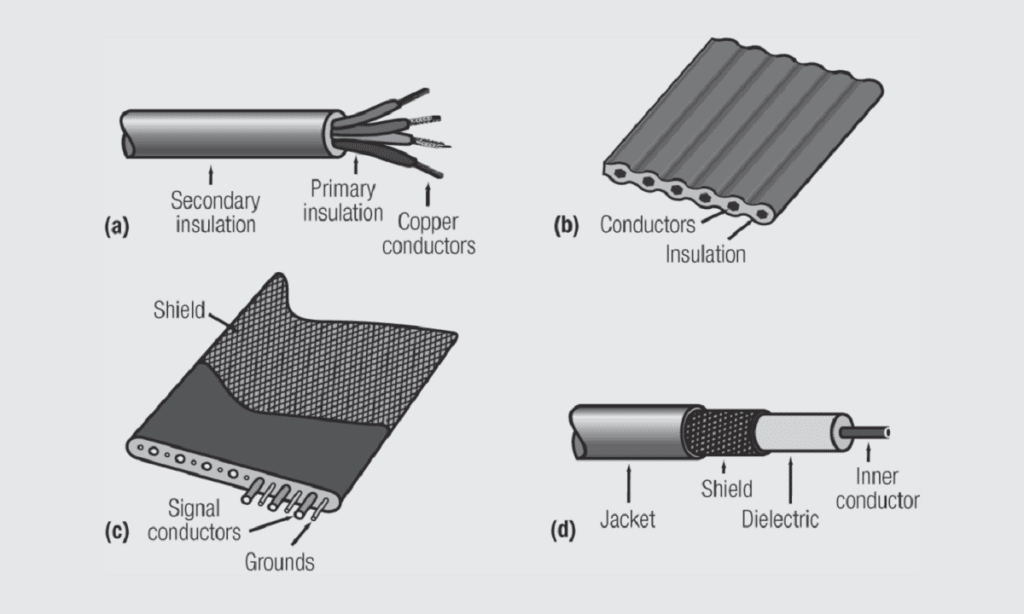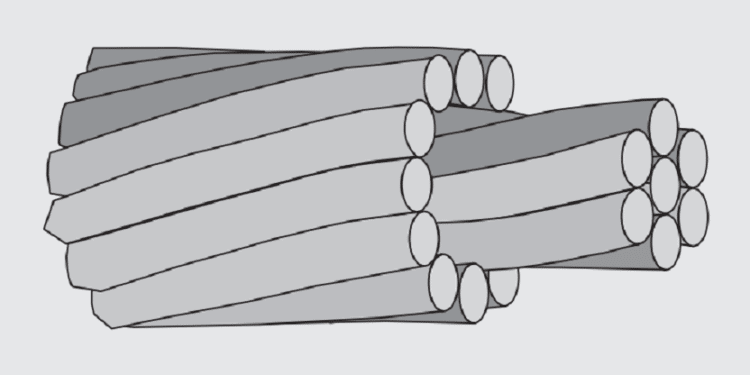As noted, there are two mechanical permanent connection technologies for wire and cable, crimped and insulation displacement connections. Crimped connections require the stripping of the insulation of the wire to expose the conductors and are made to individual wires. Insulation Displacement Connections, IDC, in contrast, do not require stripping of the insulation, the insulation is displaced during the connection process, and are generally made to multi-wire cables. Crimped connections date back to the 1940s and IDC to the 1960’s.
Before discussing crimped and insulation displacement connection details an introduction to wire and cable construction is in order.

Wire and Cable
In general, a wire is understood to consist of a conductor and its insulation. A single conductor is generally referred to as a “bare wire”. In the simplest terms a cable is a collection of wires held together by a variety of means and mechanisms. Figure 2.26 schematically illustrates several examples of wires and a jacketed cable. Figure 2.26a illustrates a wire with a solid conductor. Figure 2.26b illustrates wire with a stranded conductor, in this example seven strands. Figure 2.26c illustrates a wire with a 19 connector strand. Multistrand conductors can be arranged in a number of ways as will be discussed. Figure 2.26d illustrates a jacketed cable with four wires within the cable acket. The cable jacket both constrains and protects the wires within it. Consider now the individual components of wire and cable.
Conductors
The most common conductor material is annealed copper because of its high electrical conductivity ease of manufacturability and cost. Higher strength copper alloys are used when wire strength is an important consideration. Such alloys always compromise the conductivity however.
Aluminum conductors are sometimes used to take advantage of its weight/conductivity ratio. Aluminum is not as conductive as copper, but it is also much lighter and for a given conductivity will be lighter than a copper conductor. When aluminum conductors are used, aerospace applications for example, special attention must be paid to permanent connection techniques due to the intrinsic aluminum oxide on the surface and the tendency for aluminum to flow under load.
Copper conductors may be plated. The most common platings are tin, silver and nickel. Tin plating is used to provide corrosion protection and to enhance solderability shelf life and mechanical termination performance. Silver plating is used to optimize surface conductivity in high frequency applications. Nickel is used for high temperature applications but with a compromise in solderability and mechanical termination ease.
As noted, conductors may be solid or stranded. Stranded conductors are the most common due to their greater flexibility compared to solid conductors. Solid conductors have a higher conductivity than stranded conductors of the same diameter or gauge. Stranded conductors are preferred for crimped connections and solid conductors for IDC applications though both can be successfully used in either technology.
There are two types of stranded wires, bunch and concentric. Bunch stranded wires contain any number of strands and there is no attempt to control the relationship among strands. Concentric wires contain a central conductor with one or more layers of additional conductors wound around the central core. Concentric wires contain specific numbers of conductors because of the packing of the wires in space. The most common are 7 and 19 strands because six strands can be close packed around the center conductor and 12 more can be close packed around the seven strand conductor bundle as illustrated in Figure 2.27.

Stranded wires may be twisted. The length of a complete twist of the conductor strands is referred to as the lay of the wire. Concentric wires are always twisted while bunch stranded wires are generally not. The purpose of the lay is to provide and maintain some relationship among the strands and some control over the diameter of the bundle. Thus, twisting reduces the flexibility of the stranded conductor as well as increasing the cost. The lay and lay direction define three different types of concentric wire constructions. Consider Figure 2.28, in this case the lay of the conductors is in the same direction and with the same pitch (length of lay). This is a unilay construction. If the direction of the lay is changed but the pitch retained it is an equilay construction.
If both are changed it is called a true concentric construction because the change in both pitch and direction results in a tighter and more stable conductor bundle diameter. Bunch stranded wire without a lay is commonly used in the white goods industry for both cost and flexibility reasons. Crimped connections are made primarily to bunch stranded wire with copper conductors. Of course, the insulation must be stripped from the wire to facilitate the mechanical crimped connection. Concentric constructions are preferred for IDC applications due to the diameter control and its impact on contact force as will be discussed.

Insulation
The wire insulation provides both mechanical and electrical functions with the relative importance of each depending on the application. The mechanical functions are dependant on whether the application requires wire or cable. Figure 2.29 illustrates three examples of cables.

Figure 2.29a shows a jacketed cable, in this case there are four wires within the organizing and protective jacket. Note the reference to primary and secondary insulations. The primary insulation is the insulation on the wires themselves and the secondary insulation is the cable jacket. The primary insulation function is primarily electrical. There are two electrical functions, insulation and impedance control with insulation being common to all applications. Impedance control is relevant in high frequency applications such as coaxial cables and transmission lines. The secondary insulation performs primarily protective functions, such as abrasion and chemical resistance.
Ribbon cables, Figure 2.29b, are analogous to jacketed cables in the sense that their function is to establish and maintain dimensional control of the conductors, or wires, within the cable. The ribbon cable shown contains conductors while other constructions may consist of a collection of individual wires. Ribbon cable is widely used in IDC applications as will be discussed. In such cases dimensional control is required to ensure the proper engagement of the cable with the insulation displacement contacts within the connector housing during the termination process. Jacketed and ribbon cables are generally used in low frequency applications.
Transmission cables, Figure 2.29c are intended for high frequency applications and consist of a collection of signal and ground conductors in a controlled distribution and spacing to provide impedance control. The insulation material is selected for impedance control as well. Transmission cables are often shielded, as indicated. Transmission cables also use IDC technology.
Coaxial cables, Figure 2.29d are also intended for high frequency applications. The term “cable” applies because a shield and an outer jacket surround the “wire”, the insulation (dielectric) and inner conductor. Given this construction, different termination technologies are used with coaxial cable.
The discussion of insulation materials will be limited to the most commonly used materials. Many specialized applications exist and are outside the scope of this book.
Primary Insulations
Primary insulation materials are selected for their electrical and mechanical characteristics. For low frequency applications insulation resistance is sufficient. For high frequency applications where controlled impedance and signal transmission characteristics are important, the dielectric constant is important as is the potential for foaming the insulation to further reduce the effective dielectric constant. Mechanical requirements are application dependent as well with flexibility and abrasion resistance among the more important characteristics.
PolyVinylChloride
PVC is the dominant low frequency insulation material due to a combination of cost and manufacturability of a variety formulations to optimize mechanical performance for a range of applications. High frequency use is limited by dielectric constant and associated capacitive losses.
Polyolefins
The properties of polyethylene, PE, insulations are dependent on the processing of the polymer. Both low and high density formulations are used. Low Density PE, LDPE, has good mechanical properties and a low dielectric constant making it suitable for high frequency applications, particularly in foamed versions. High density PE, HDPE, has better mechanical characteristics and a slightly higher temperature range than LDPE.
Polypropylene, PP, has similar properties to PE but with better abrasion resistance and a higher temperature capability, 105 degrees C compared to 80/90 for LDPE/HDPE.
Fluorinated Hydrocarbons
The fluorinated hydrocarbons, polytetrafluoroethylene, PTFE, polyfluoroethylenepropylene, PFEP, and polyvinyledinefluoride, PVDF, have superior electrical, mechanical and temperature capabilities than PVC and the polyolefins, but at a cost premium that limits their use to the most demanding application.

Secondary Insulations
As noted earlier, cable secondary insulations are primarily intended to provide mechanical and chemical protection to the cables during routing and manufacturing of equipment. Several secondary insulation materials are natural and synthetic rubber compounds.
Polychloroprene Rubber
Like PVC, PCR, is compounded in a variety of formulations to support different application requirements. PCR has a good balance of mechanical properties and chemical resistance.
Ethylenepropylene Rubber
EPR is a polyolefin copolymer with good chemical and solvent resistance as well as good mechanical and electrical properties.
Polyurethanes
Thermoplastic and elastomeric polyurethanes have good mechanical properties but limited electrical performance.
Polyamides
Several polyamide formulations are available with good chemical and solvent resistance and low coefficients of friction. Some varieties, however, have high moisture absorption and limited flexibility.
With this overview attention now turns to mechanical permanent connections to wire and cable, beginning with crimped connections.






